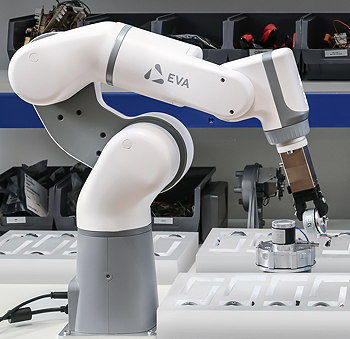UK start-up attracts $7.4m to back £4,990 industrial robot

A British robot developer has attracted $7.4m in funding to back the launch of what it describes as the first desktop robot for industrial use. London-based Automata has been working on its six-axis Eva robot since it was founded in 2015, and is now offering the lightweight, user-friendly robotic arms for £4,990 ($6,535) – about a quarter of what some mainstream robot manufacturers charge for a similar machine.
The 9.5kg collaborative robots can lift payloads of up to 1.25kg, with a reach of 600mm and a repeatability of ±0.5mm. They are said to be particularly easy to program using a pair of buttons built into the arm, which are used in combination with specially developed graphical software.
Automata was set up by two former architects, Mostafa ElSayed and Suryansh Chandra, who discovered some of the limitations of conventional robots when they tried using them for a project at their former employer, Zaha Hadid Architects. They found that standard robots were too costly, inflexible and difficult to use, so they decided to develop their own but it has taken much longer than they originally thought to bring their machine to market.
Part of the reason for this was that they decided to develop their own gears for the robot’s axes. They found that existing precision gears were too expensive and were a large factor in the high costs of other robots. The prices of these gearboxes are controlled by a handful of suppliers who Chandra describes as “the gatekeepers to robotics”. They also tie robot designers into suppliers of other components such as motors.
“The history of Automata is the history of its gearbox,” says ElSayed. “We grew the company around the gearbox. It took us four years to crack the gearbox problem.” One reason that it took so long is that the gearboxes had to undergo extensive mechanical trials. “We had to test our arms under load for months on end,” he reports.
Automata’s founders claim that their patented gearbox delivers about 80% of the performance of existing precision offerings, for about 20% of the cost. “That’s how we achieve Eva’s price point,” says Chandra.
The other challenge they faced was to make their robot easier to program and use. They believe that the “clunky” control boxes and tablets needed to program most industrial robots are a barrier to entry and that “technology can make robots much easier to program”.
The alternative they came up with is a pair of buttons (for waypoints and backdriving) built into the robot arm. The arm is linked wirelessly to browser-based graphic software, called Choreograph, running on a PC – typically a laptop.
The programmer presses one of the buttons and moves the arm. This is reflected almost immediately on the PC with the 3D movement mapping to a 2D screen representation. Waypoints can be edited graphically on-screen. A timeline shows key frame animations depicting the robot’s movement in a simple sequence.

The robot’s controller is built into its base, which includes connections for analogue and digital I/O, and an emergency stop.
There are already several pilot installations of the Eva arm. One is at Qualitech Components, a Cambridgeshire-based manufacturer of etched metal products. The company, which is expanding by about 25% a year, needed automation to help it cope with its growth. It installed an Eva arm to pick up and move thin metal sheets and according to the company’s managing director, Alexander Craig, the robot was “up and running in 70 minutes”. He adds that since the arm was installed last November, it has worked “flawlessly” and has allowed Qualitech to upskill staff who had previously been machine loaders “to do more interesting things”.
The Eva arms are being built for Automata by the Northumberland-based sub-contractor, Tharsus, which also makes robots for Ocado. The company is investing £5m in a factory to manufacture high-tech products.
To date, Automata has raised $9.5m in funding, with earlier investors including ABB, LocalGlobe, Entrepreneur First and Innovate UK. The latest round of funding, led by Hummingbird Ventures, and including firstminute Capital and Hardware Club, will be used to expand Automata’s team of 42 at its London headquarters, and to boost the production of Eva.
The company is now selling the robots online to customers in the UK and Europe. “We are extremely proud to offer Eva at the price point we do,” says Chandra. “People can visit the Automata Web site and buy a piece of industrial quality equipment on their credit card – it doesn’t get much more accessible than that.” He believes that Eva will open up robotics up to manufacturers doing short production runs, and allow them to offer a high degree of customisation. He hopes to sell “hundreds” of the arms this year.
“Mostafa and I started Automata to democratise robotics and to ultimately allow anyone to seamlessly use a robot,” Chandra adds. “It’s been a long road to get here. We’ve had to vertically integrate and design everything from the ground up. But it’s starting to pay off.”





